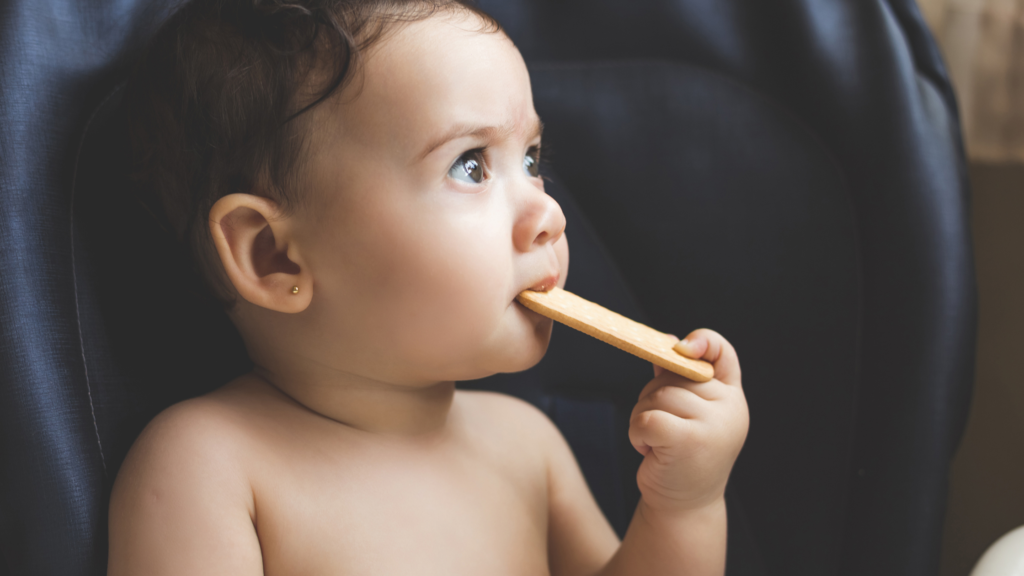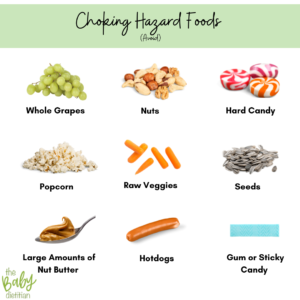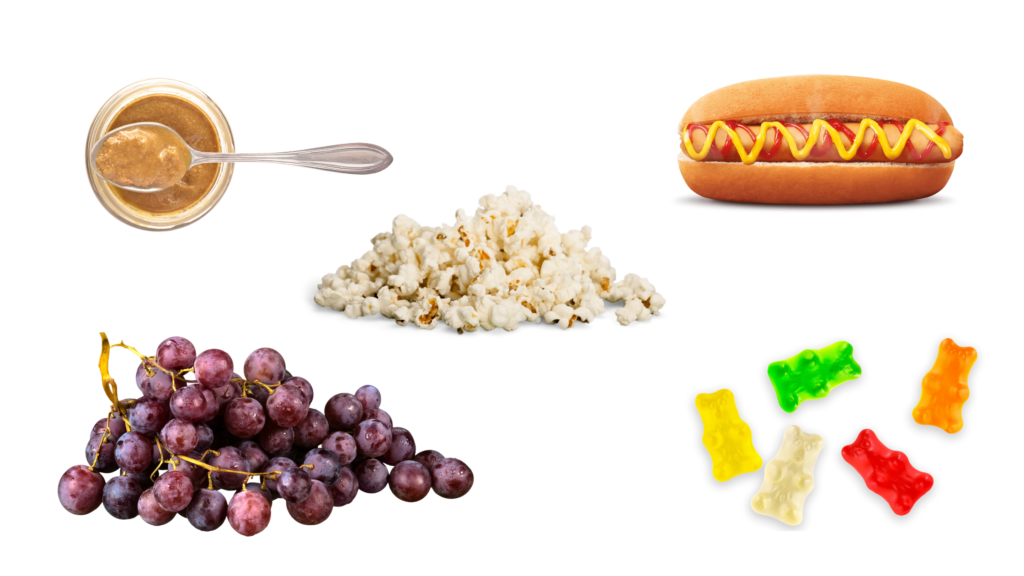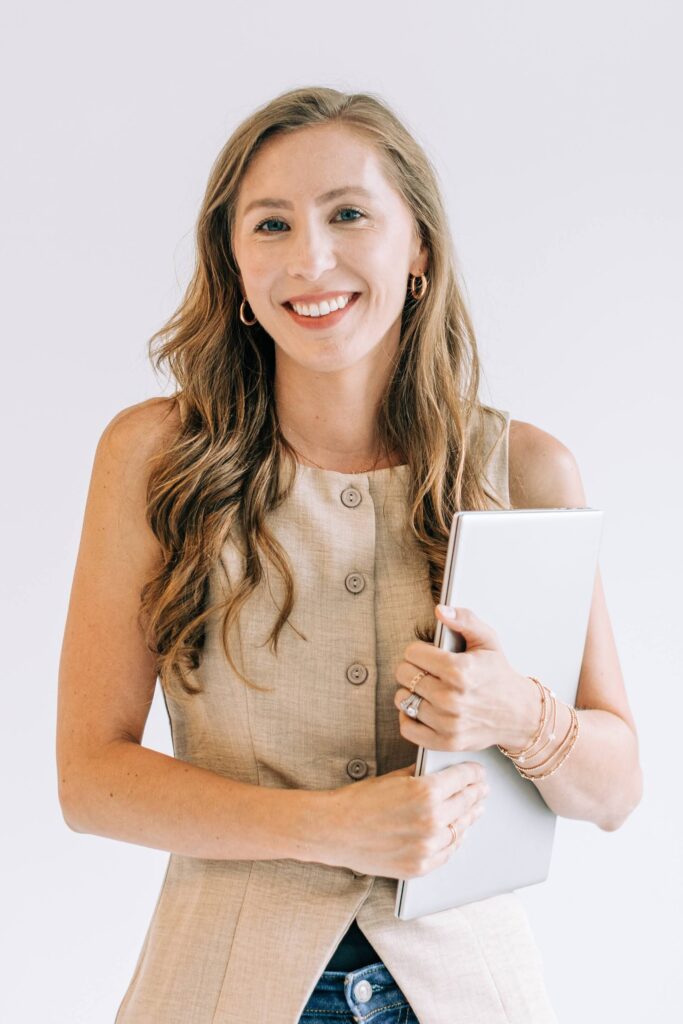Choking Hazards when Starting Solids



Some of the links below are affiliate links. At no additional cost to you, I will earn a commission if you click through and make a purchase.
Choking Hazard Foods
Are you feeling uneasy introducing solids to your baby because you’re afraid of choking?
Choking can be a serious matter, both for children and adults. When we’re talking about children, however, there are a lot of foods that can pose a risk for choking since their airways are a lot smaller than adults, and they are still learning how to chew and swallow!
You’re not the only one feeling nervous about this topic, many parents are! I hope this post will help give you the confidence you need to start your baby on solids and feel more at ease.
This post will walk you through things you need to consider before starting solids, how to prevent choking incidents while eating, common choking hazard foods, and what you can do to offer foods safely.
Signs of Readiness for Starting Solids
Knowing the signs of readiness is pivotal in ensuring not only the success with starting solids, but also the reduction of the risk of choking on foods.
Before starting your baby on solids, look for these signs of readiness:
- Baby is able to sit up unassisted
- Baby has good head and neck control to reduce the risk of choking
- Baby opens their mouth when food is offered
- Baby is able to self-feed by bringing hands and objects to the mouth
- Baby tries to grab small objects, such as toys or food
- Baby is able to move food from the front to the back of the tongue
- Baby can swallow food (rather than pushing food back out)
- Baby is around 6 months of age
How to prevent your child from choking while eating:
- Have your child sit up while eating. This means no lying down, crawling, or moving and walking around.
- Have your child sit in a high chair or other safe places that allow them to sit up properly and be able to sit still.
- Avoid letting your child eat in the car or stroller, or any vehicle that is in motion.
- Lastly, keep mealtimes calm! Avoid distractions, disruptions, and rushing when eating. Remove distractions such as loud noises, animals, TV, music, etc. We want the baby to be able to focus on the meal and not be scared or surprised by loud noises that could disrupt their concentration on chewing and swallowing.

Choking Hazard Foods
This is a list of potential choking hazard foods for young children from the CDC. It is important to note that this list may not include all types of foods that can be a choking hazard! In general, you want to avoid small, sticky, or hard foods that are difficult to chew and swallow.

Fruits and Vegetables
- Cooked or raw whole corn kernels
- Uncut cherry or grape tomatoes
- Pieces of hard raw vegetables or fruit, such as carrots or apples
- Whole pieces of canned fruit
- Uncut grapes, berries, cherries, or melon balls
- Uncooked dried vegetables or fruit, such as raisins
Proteins (nuts, seeds, meat, beans, cheese)
- Nuts and seeds that are whole or chopped
- Chunks or spoonfuls of nut and seed butter, such as peanut butter
- Meats that are tough or in large chunks
- Hot dogs, meat sticks, or sausages
- String cheese and any large chunks of cheese
- Bones found in meat or fish
- Whole beans
Grain Products (cookies, crackers, bread)
- Cookies or granola bars
- Chips, pretzels, popcorn, or other similar snacks
- Crackers or bread with seeds, nut pieces, or whole grain kernels
Sweets and Candies
- Round or hard candy, jelly beans, caramels, gum drops, or gummy candies
- Chewy fruit snacks
- Chewing gum
- Marshmallows
The American Academy of Pediatrics (AAP) actually states to keep these types of choking hazard foods away from children younger than 4 years. Again, this is just a list of potential choking hazard foods, but there can be other foods out there.
If you want to learn how to safely cook and prepare over 100 different foods for your child between the age of 6-12 months, grab a copy of our baby-led feeding cookbook.

Other tips to prevent choking in children
Cook and prepare food to the proper shape, size, and texture for your child’s development. Your child’s development may not be the same as another child’s, so watch for signs that your baby is able to eat foods safely before moving on to the next stage of food.
Milk & Grow has her own post on choking hazard foods where she categorizes what foods are hazards at what age, and ideas on what you can do to modify these foods! Read her post about Choking Hazard Foods For Babies And Toddlers 6-24 Months.
One of the most important ways to ensure safety is to simply pay attention to what your child puts in their mouth. It is super important to supervise your child whenever they are eating. Choking can be silent, so we want to make sure we are continuously paying attention.
Do not pressure the child to eat if they are not showing signs of interest, such as leaning forward and opening their mouth for food or self-feeding themselves. Pressuring the child to eat is a no-no for many reasons, including corresponding with food aversions and picky eating.
Child needs to be in an upright position with their feet resting on a footrest for proper stability and control. This helps them with coordination and balance, which aids in a safer meal time.
Lastly, allow your child to self-feed! It is much easier for them to know where the food is in their mouth when they are the ones feeding themselves. This decreases the risk of choking by allowing the child more control over the food when picking up and bringing it to their mouth, as well as more awareness of the food when placed in mouth. This helps them learn how to maneuver the food, chew, and swallow safely.
Baby-Led Weaning and Choking Risk
Baby led weaning is a feeding method for starting solids where the baby is self-feeding themselves with finger foods instead of starting with purees. This idea of feeding finger foods has been leaving parents even more nervous about choking!
However, there is research concluding that baby-led feeding does not increase the risk of choking compared to traditional ways of feeding purees:
- No difference in self-reported frequency of choking between infants introduced to solid foods using a baby-led weaning or traditional spoon-feeding approach
- A Baby-Led Approach to Eating Solids and Risk of Choking
When considering the size of food to offer, start off with larger-sized foods rather than small pieces. This may sound counterintuitive, but hear me out.
When a child bites off a too big piece of food, they will gag it out in response which protects the airway.
“For example, it would be hard for a 6-month-old to choke on a two-inch thick, long strip of steak they are sucking on but entirely possible for them to choke on a small chunk of meat that makes its way to the back of their tongue.”- Solid Starts
You generally want the food to be big enough that it would be difficult for the baby to put the entire thing into their mouth.
Choking vs Gagging

Gagging is a perfectly normal part of the feeding process. In fact, gagging is the natural way your baby’s body works to protect itself from choking. Gagging is how your child learns how to maneuver and handle foods in their mouth.
Your baby’s gag reflex is farther forward in the mouth when first starting solids. This is natural to better protect them from choking. The gag reflex will move back towards the back of their mouth as they age! Therefore, coughing, gagging, and expelling food will be common during the first few months of starting solids.
Choking, on the other hand, is a sign that your baby’s airway is blocked. This is when a piece of food has partially or fully blocked their windpipe, and their gag reflex didn’t successfully force it out to protect them.
Conclusion:
Choking is a serious concern, especially among children, however, being knowledgeable about choking hazard foods and setting up mealtime safely will decrease the risk of choking.
- Introduce solids to your baby only if they are showing signs of readiness.
- Recognize the qualities that make foods a choking hazard, such as small, sticky, hard, and slippery foods, and offer foods that are developmentally appropriate.
- Set up your child in a safe space to eat and alway pay attention to what they put in their mouths.
Choking means your baby is in danger, and it could be life-threatening. Immediate action should be taken and 911 should be contacted as soon as possible.
I encourage every client to take a CPR course prior to beginning solids because you can never be too careful or too prepared.
If you need more support from a pediatric dietitian and starting solids expert, join my self-paced Starting Solids 101 Course.

Cinthia Scott is a Registered Dietitian (RD) and International Board Certified Lactation Consultant (IBCLC) , with over 10 years experience in the field of dietetics. Cinthia focuses on ensuring optimal nutrition in the first 1000 days of life to ensure optimal growth and development as well as set the stage for long-term health. Cindy is an author, starting solids expert, and advocate for caregivers receiving evidence based education and support surrounding breastfeeding and starting solids.
Cinthia is co-author of the 101beforeone Starting Solids Book, “101beforeone -baby-led feeding cookbook,” and is the founder and owner of The Baby Dietitian LLC which is her private practice built to provide virtual 1:1 services for caregivers surrounding infant nutrition, toddler nutrition, and breastfeeding support. Cinthia is also the creator of the Starting Solids 101 Program which provides caregivers 1:1 support from a Pediatric Dietitian on how to provide optimal nutrition from the start and create healthy eating habits that will last their whole lifetime. To work with Cinthia, you can access her services here.
Cinthia provides tons of free information for parents on her social media accounts as well.
- Instagram: @The.Baby.Dietitian
- Tiktok: @The.Baby.Dietitia

2 Responses